Autoflash with One Receiver
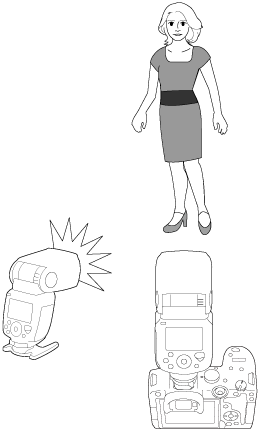
This section describes basic fully automatic wireless shooting with an EL-5 attached to the camera as a sender and an EL-5 set as a receiver.
-
Set up a unit as the sender.

-
Set up a unit as the receiver.
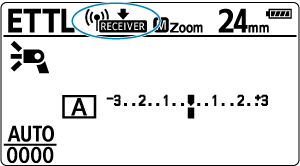
-
Check the channel and ID.
-
Position the camera and other Speedlite.
- Position them within the range shown in Positioning and Range.
-
Use the joystick on the sender to select
.
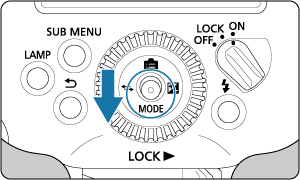
-
Set the flash mode to
.
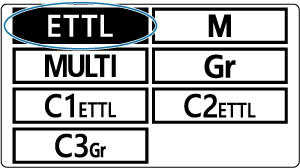
- Press the joystick vertically or horizontally or turn
to select
, then push the joystick straight in.
- The receiver is automatically set to
during shooting, as controlled by the sender.
- Confirm that firing group control is set to
.
- Press the joystick vertically or horizontally or turn
-
Check the connection and make sure the flash units are charged.
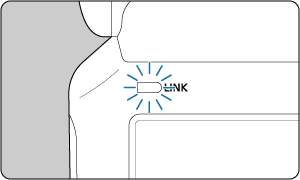
- Confirm that the
lamp is lit in green.
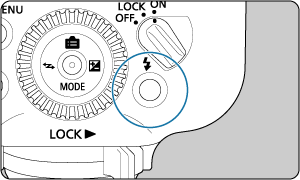
- Confirm that the sender and receiver flash-ready lamps are lit.
- The sender beeps after all Speedlites have been recharged when P.Fn-05 is set to [0] ().

- Confirm that the
icon (1) indicating completion of sender/receiver charging appears on the sender LCD panel (
is not displayed).
- For details on sender LCD panel illumination, see LCD Panel Illumination.
- Confirm that the
-
Check operation.

-
Take the picture.
- Just as in normal flash photography, shoot after configuring the camera.
Caution
- Radio transmission is not possible unless the
lamp is lit. Double-check the transmission channels and wireless radio IDs of senders and receivers. If you cannot connect with the same settings, restart the senders and receivers.
Note
- Flash coverage of the sender and receiver is set to 24 mm. You can also set the flash coverage manually.
- The sender can also fire ().
- You can fire the modeling flash by pressing the camera's depth-of-field preview button when an EL-5 is set as a receiver (). Modeling flash cannot be fired this way when an EL-5 is set as a sender.
- Auto power off takes effect in approx. 5 min. when the Speedlite is set as a sender.
- To turn on a receiver that is in auto power off mode, press the sender test flash button.
- Test flash firing is not available while a camera's flash timer or similar functions are active.
- You can change the time until auto power off takes effect on a receiver in C.Fn-10.
- You can set up beeping when all Speedlites (senders and receivers) are fully charged in P.Fn-05.
LCD Panel Illumination
In wireless flash photography, the sender LCD panel is on or off depending on whether senders and receivers (firing groups) are charged.
The sender LCD panel is lit when the sender and receiver are not fully charged. LCD panel illumination turns off approx. 12 sec. after senders and receivers are fully charged.
The sender LCD panel is lit again when sender and receiver charging resumes as you take pictures.
Caution
is displayed on the sender LCD panel as long as the sender or any receiver (firing groups) is not fully charged. Before shooting, confirm that
is not displayed on the LCD panel.
Flash Photography Applying Wireless Features
The wireless system eliminates the need to set up the following features on receivers, which are automatically configured based on sender settings. This enables wireless flash photography much like normal flash photography.
- Flash Exposure Compensation
- Flash Exposure Bracketing
- FE Lock
- High-Speed Sync
- Second-Curtain Sync
- Manual Flash
- Stroboscopic Flash
Note
- You can also set flash exposure compensation and flash coverage manually on each receiver.
- With an EL-5 set as sender, wireless second-curtain sync shooting is possible with these units set as receivers: EL series units (except EL-100), 600EXII-RT, 600EX-RT, or 430EX III-RT.
Using Multiple Senders
Multiple devices can be set as senders. Wireless flash photography under the same lighting arrangement (with the same receivers) is also possible using other cameras, by switching the camera that the sender is attached to.
is displayed on the LCD panel when multiple senders are used.
Caution
lamps that are off or
display on LCD panels indicates that the Speedlites are not connected. After checking the transmission channel and wireless radio ID, restart each sender.
- Do not exceed a total of 16 senders and receivers in wireless flash photography.
Note
- Flash photography is possible even when the sender is a sub-sender.